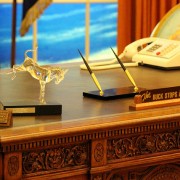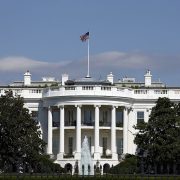CBO Paints a Bleak Picture for Future Non-Defense Spending
By Daniel Sheehan
AFOP Executive Director
On January 24, the nonpartisan Congressional Budget Office (CBO) released its annual Budget and Economic Outlook covering the ongoing fiscal year 2017 and the ten-year 2018-2027 period and painting a very bleak picture for future spending. While I appreciate that budget matters can be a little technical and dry, I encourage you to read on so you can understand the fiscal realities facing federal decision-makers.
Of the big picture, CBO economists are said to be projecting real economic growth to stay just below two percent per year for the next decade, limiting how much federal tax receipts will grow. Inflation will also stay at about two percent per year, but rising interest rates will increase federal spending on debt interest significantly. The persistent structural imbalance between what the federal brings in and what it spends will mean ballooning federal deficits. CBO projects the deficit in the current fiscal year 2017 to be $559 billion; however, the office says the deficit will breach the trillion-dollar threshold as soon as FY 2023, reaching $1.4 trillion in 2027. The ten-year cumulative deficits over the 2018-2027 period are projected to total $9.4 trillion. When these deficits are added to the cost of federal loan programs also financed by federal borrowing, CBO projects that the public debt held will rise by $10.1 trillion over the next decade, reaching $24.9 trillion at the end of 2027. That amount would equal 89 percent of one year’s Gross Domestic Product (GDP).
Compounding matters is what budget analysts have predicted for decades: an aging population drives mandatory entitlement costs (like Social Security, Medicare, and Medicaid) higher and higher, while the 2011 Budget Control Act (BCA) constrains discretionary spending for the time being (and rising entitlement and net interest costs “crowd out” discretionary spending later on down the line). This is not just a macro level concern, because almost all federal spending on the workforce system is classified as “non-defense discretionary.”
The news is particularly bad for non-defense discretionary spending in the upcoming fiscal year 2018. BCA placed legally binding annual caps on total defense and non-defense discretionary appropriations. If Congress enacts appropriations bills that exceed the cap levels, another round of budget sequestration must occur to reduce all spending down to the cap levels.
You will recall that, back in 2012, the “Super Committee” (Joint Committee on Deficit Reduction) failed to agree on a deficit reduction plan, triggering a dramatic reduction in spending caps. Since then, two-year budget deals in 2013 (covering fiscal years 2014-2015) and 2015 (covering fiscal years 2016-2017) have raised the caps for those years in exchange for reduced spending in other areas down the road. As a result, however, the cap levels for 2018 are now lower, in nominal dollars, than the 2017 levels. The defense cap drops by $2.0 billion and the non-defense cap drops by $2.9 billion.
The CBO baseline for discretionary spending assumes the previous year’s appropriations plus an across-the-board inflation adjustment. (This year, it is two percent). Baseline appropriations levels for fiscal year 2018 are $53.1 billion above the combined cap levels ($13.5 billion on defense and $39.6 billion on non-defense). Even if you give fiscal year 2018 non-defense appropriations a hard freeze at the fiscal year 2017 levels (which are based on the ongoing continuing resolution, which is a hard freeze at the fiscal year 2016 levels for NFJP and most other U.S. Department of Labor programs), total non-defense appropriations would still be about $11 billion over the fiscal year 2018 spending cap, forcing another round of sequestration. The new president has discussed increasing defense spending above current levels and decreasing non-defense spending, but any cap changes would have to be implemented through legislation requiring at least 60 votes in the Senate for approval.
While budget problems pose, admittedly, very difficult challenges, Congress and the White House must and soon find a way to forge a bipartisan budget plan to preserve the BCA’s equal treatment of defense and non-defense discretionary spending, provide reasonable cap relief, and make the necessary long-term fiscal fixes to sustain adequate investments in the nation’s infrastructure and its people. These are the realities our leaders face, and these are the challenges they must overcome.







